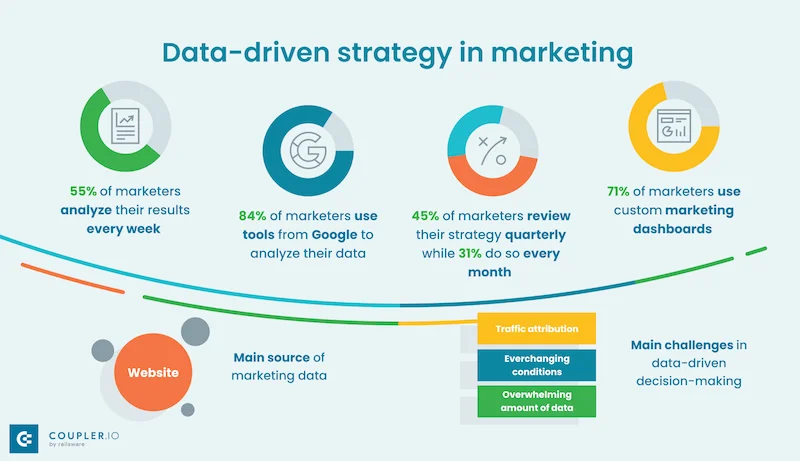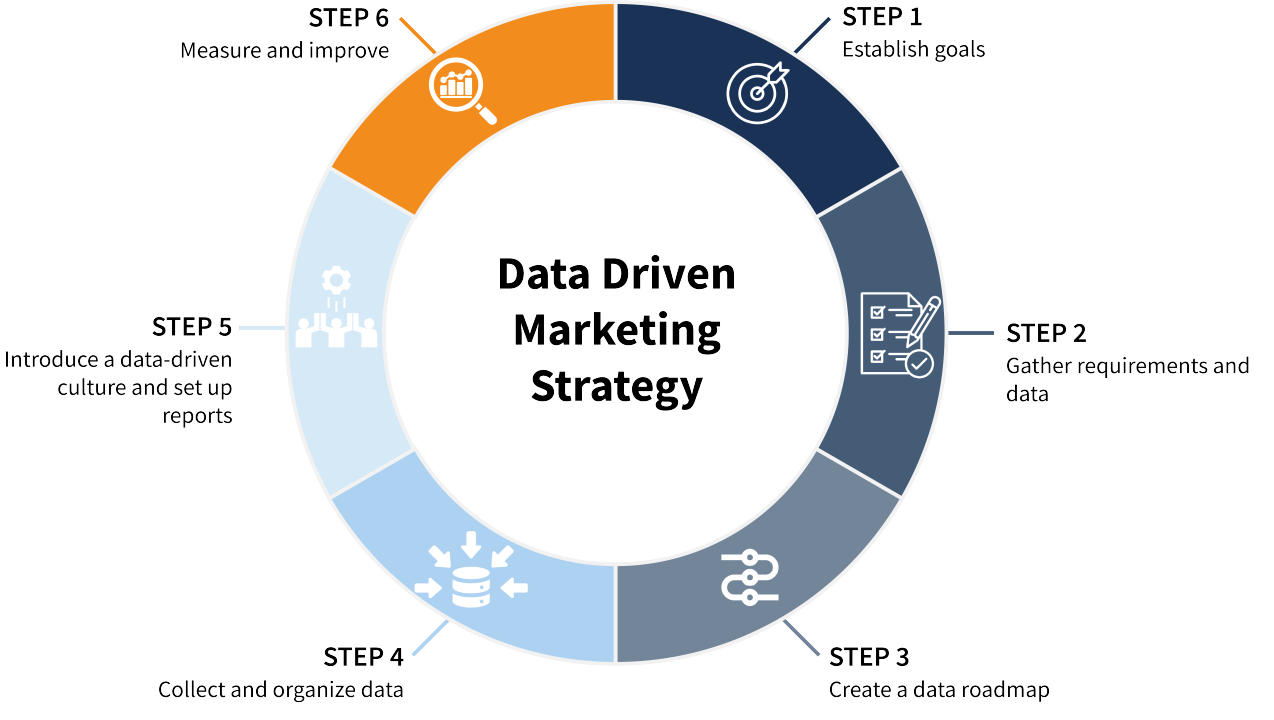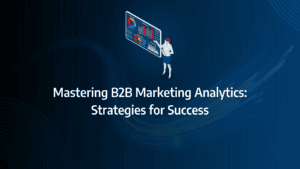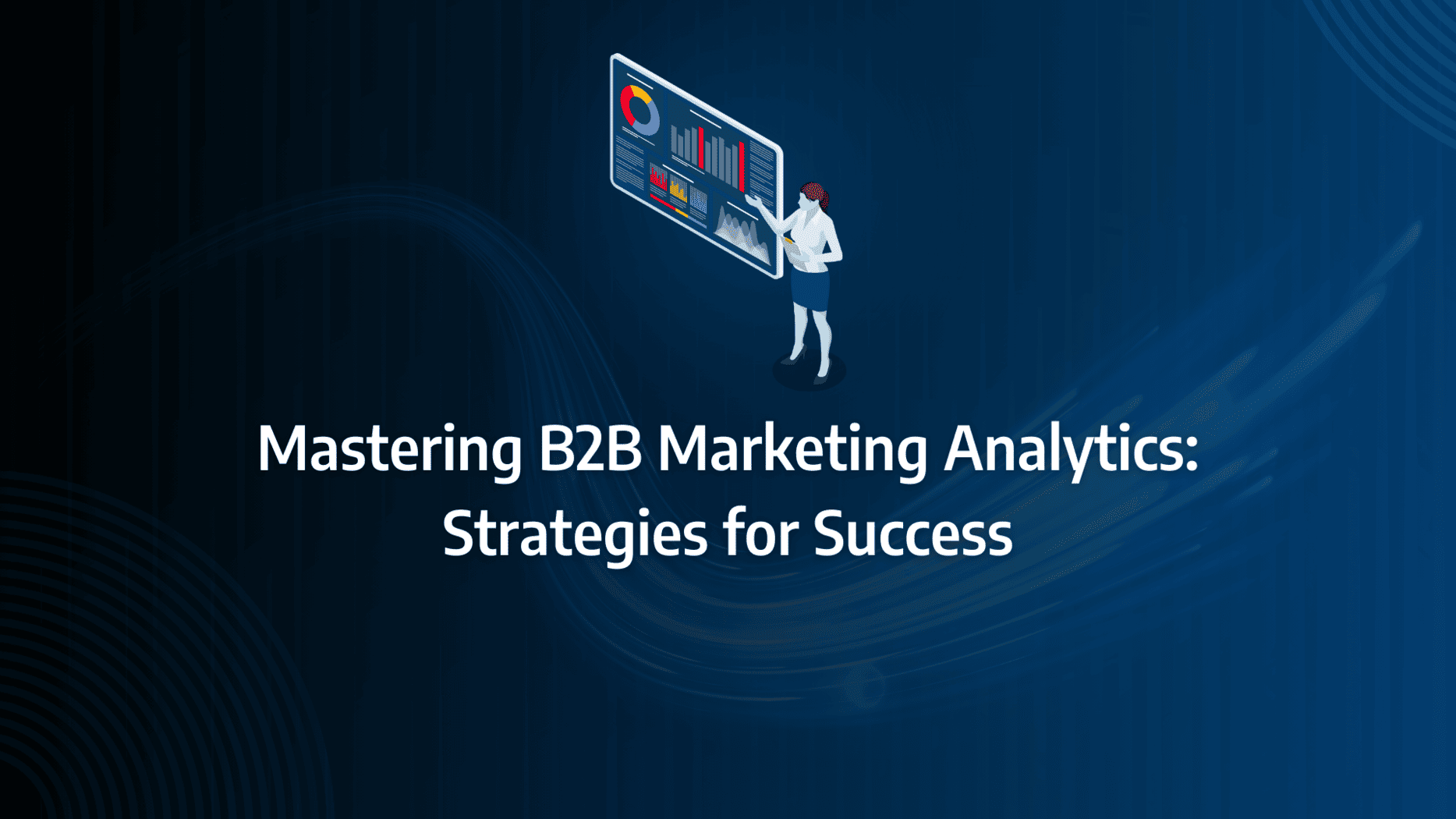Data has become the backbone of successful marketing strategies. Without the right insights, even the most innovative campaigns can fall short. As businesses strive to stay competitive, the role of analytics in digital marketing has never been more crucial. Understanding how to leverage data to drive marketing decisions can transform your approach, leading to enhanced customer engagement, optimised campaigns, and, ultimately, higher ROI.
In this guide, we delve into the strategies that can help you harness the power of analytics, offering practical steps to elevate your digital marketing efforts and achieve data-driven excellence.
- Identify Key Metrics: Focus on the metrics that align with your business goals. Prioritise actionable data that directly influences decision-making to drive better results.
- Leverage Predictive Analytics: Use predictive analytics to anticipate future trends and customer behaviours, enabling more informed marketing strategies.
- Optimise Campaigns Continuously: Regularly review and refine your campaigns based on real-time data to ensure ongoing effectiveness and efficiency.
- Utilise A/B Testing: Implement A/B testing to compare different versions of your marketing assets, helping you identify the most impactful elements.
- Integrate Data Across Platforms: Ensure seamless integration of data across all your marketing platforms to create a unified view of customer interactions and campaign performance.
- Enhance Personalisation Efforts: Use analytics to better understand your audience and tailor your messaging for a more personalised and engaging customer experience.
- Automate Reporting: Automate your reporting processes to save time and provide your team with up-to-date insights for quicker decision-making.
- Invest in the Right Tools: Select analytics tools that best fit your business needs, ensuring you can efficiently collect, analyse, and act on your data.
- Stay Updated with Industry Trends: Keep abreast of the latest developments in digital analytics to continually refine your strategies and maintain a competitive edge.
- Train Your Team: Equip your team with the necessary skills and knowledge to interpret data effectively, fostering a data-driven culture within your organisation.
What are Data Analytics in Digital Marketing?
Data analytics in digital marketing refers to the tools and techniques used to analyse and report on marketing data collected through various digital channels where your brand has a presence. These channels include social media platforms like Facebook, Instagram, and LinkedIn, as well as your display or search ads, email campaigns, affiliate marketing sites, and more.
Digital analytics tracks and measures the performance of all your business’s online channels and campaigns. It provides crucial insights into the buyer’s journey and the impact of your marketing campaigns on conversion rates. Armed with this data, you can pinpoint which areas are delivering a solid return on investment, which areas need improvement, and the specific actions to take. This might reveal new revenue opportunities or identify underperforming channels previously thought to be essential.
By adopting a data-driven approach to marketing, digital analytics allows you to step back, gain a comprehensive view, and discern what is effective in your overall strategy. Consequently, you can make informed adjustments to produce better results.

What are the key metrics I should track in digital marketing analytics?
5 Digital Marketing Metrics That Actually Matter
Entering the world of digital marketing data can be overwhelming, especially if you’re just starting. However, focusing on your goal and the buyer’s journey will ultimately help you increase your revenue tied to ROI. Here are five critical metrics to focus on for actionable insights into your business efforts:
- Traffic Quality While traffic volume can be a vanity metric, focusing on the quality of traffic can significantly enhance your marketing strategy. This involves segmenting your traffic by source and analysing demographic data, bounce rates, time spent on page, and the proportion of new versus returning users.
- Engagement Engagement refers to the likes, shares, and comments your posts receive on social media. High engagement indicates that users are connecting with your content, which often leads to more qualified leads. Tracking engagement can help refine your content strategy to better connect with potential customers.
- Conversions Conversions are actions taken by users that are valuable to your business, such as signing up for your blog, making a call, or purchasing a product. Different businesses assign different values to conversion rates. By tracking conversions, you can identify the steps users take before becoming customers and optimise this journey to improve your overall conversion rate.
- Click-Through Rate (CTR) CTR measures the relevance of your audience in response to your paid ads. A low CTR may indicate the need to revise your offer, improve your landing pages, or better target your audience. It’s a direct indicator of how well your ad is performing in terms of attracting the right users.
- Site Load Speed According to Kissmetrics, 40 percent of users abandon a website that takes more than three seconds to load, representing a significant loss of potential traffic. Google PageSpeed Insights is a valuable tool to check your website’s load time and identify key areas for improvement to ensure optimal speed and user experience.

By focusing on these key areas of digital marketing data, you can develop an analytics-driven marketing strategy that leverages precise data insights to enhance your marketing efforts. Integrating these strategies will help you to better understand your audience, improve engagement, and ultimately drive higher conversion rates.
What Matters Most?
From our experience, the true value in analytics lies not in the sheer volume of data but in distilling it into actionable insights. Clients often discover that a focused approach, where less becomes more, is key when selecting KPIs that directly drive business outcomes. Typically, integrating cross-channel data is essential to building a cohesive understanding of the customer journey, a move that has proven critical for aligning marketing strategies. We have also seen how evolving from descriptive analytics to prescriptive insights can shape future strategies, enabling a shift from merely understanding what happened to predicting and optimising future outcomes.Get In Touch
The 6-Step Marketing Data Analysis Strategy to Drive Business Growth
1. Define a Problem
To begin, you need to clearly identify what you aim to achieve or the specific problem you wish to solve. This clarity will guide you on which digital marketing data to track and how to analyse it. Tracking the wrong data or conducting incorrect digital marketing data analysis can lead to misguided assumptions. Similarly, making decisions without solid data can hinder your progress in a measurable way.
Ask yourself what you want to know or what problem you want to solve. At this stage, it’s acceptable to be general, but ensure your problem has a Key Performance Indicator (KPI) attached. This could be leads, brand awareness, sales, conversion rates, or ROI. This sets the stage for the subsequent steps in the digital marketing data analysis process.

2. Set Data-Driven Goals
With your problem and objective defined, the next step is to set measurable goals that help determine if you’re on the right track. Effective digital marketing data analysis must be rooted in goals and benchmarks to give the numbers significance. These goals should be informed by previous digital marketing data analysis or other benchmarks you’ve gathered. Aim for goals that are challenging yet achievable.
To fine-tune your goals, establish the performance level needed to achieve them. This specificity will guide you on what needs improvement and the extent of those improvements required to reach your goal.

3. Collect Accurate Data
Collecting accurate data is crucial to draw valid conclusions and focus on the right improvements. Your digital marketing data analysis tools must be dependable and the data should be straightforward to interpret.
To gather data effectively, you’ll need mechanisms to track user behaviour. These can include the appropriate codes, URLs, or plugins that reveal how a user arrived on your page, what they clicked on, or if they viewed an ad. Examples include Google Analytics JavaScript snippets, URL tracking codes, Facebook Pixel, or HotJar plugins. Ensure these tracking devices are correctly configured to capture the relevant events. For instance, Google Analytics snippets might need adjustments to track conversion events accurately.
Once your tracking tools are in place and events are set up, you’ll need to integrate them with a data gathering or compilation platform to assess your digital marketing data analysis strategy comprehensively. This could involve integrating your website and analytics tools with a CRM system like HubSpot, or using a data compilation platform such as Data Box or Google Data Studio.
Source: Gartner
4. Make Informed Changes
To meet your goals, you need to decide what changes to make and how to implement them. At this stage, hypothesise potential changes based on prior digital marketing data analysis or other informed estimates. Utilise A/B testing or user testing, and individually assess the results to gauge the impact of each change. It’s beneficial to start with changes you’ve previously implemented, as this gives you a reference point for success and experience.
5. Experiment and Advance
Having achieved your goal for your landing page, it’s vital to recognise that digital marketing strategies and data analysis are never static. The digital marketing landscape evolves continually with technological advancements, necessitating a dynamic approach to remain effective. To sustain growth, you need to adopt innovative methods and consistently monitor these improvements. This often involves experimenting with emerging trends. For instance, we updated this post in 2020 to revisit previous challenges and explore contemporary, creative solutions to maintain progress over the years.
6. Assess and Pivot
When you experiment with new trends, it’s crucial to meticulously analyse new data and actively seek feedback from your team. Many new marketing trends lack extensive testing, and managers may not have extensive experience with these fresh approaches. Nonetheless, this scenario presents a unique opportunity to outpace competitors who might be hesitant to adopt new marketing media or strategies. While it involves some risk, the potential rewards can be substantial.
If an initial strategy fails, it’s important not to dismiss it outright. Instead, investigate what specifically didn’t work. Identify the reasons behind the shortcomings and determine if these issues can be resolved. Leveraging your digital marketing data analysis strategies and your team’s insights can provide answers to these questions, guiding you towards refining and improving your approach.
How do successful companies use data analytics to improve their marketing efforts?
One of the most advantageous aspects of big data is its widespread adoption by marketers and successful companies. This prevalence makes it straightforward to find real-life examples of how big data is utilised in digital marketing processes. Here are some notable examples of companies that effectively leverage data analytics in digital marketing to enhance their operations and outcomes.
1. Netflix
Netflix is a prime example of a company that extensively uses big data to refine its services. Most prominently, this is seen in their data-driven recommendation platform, which tailors content suggestions based on user behaviour and preferences. This approach has significantly strengthened Netflix’s connection with its audience, saved money, and influenced the type of content produced. When looking for effective analytics-driven marketing strategies, Netflix’s use of big data stands out.
2. Amazon
Similar to Netflix, Amazon employs big data to personalise customer experiences and enhance satisfaction. However, Amazon’s approach is more comprehensive due to its vast customer base and diverse services. Their machine learning algorithms synchronise with data to optimise elements like product recommendations and customer reviews. This integration of digital marketing data is a key driver of Amazon’s sales, illustrating the substantial benefits of a data-centric strategy.
3. Kroger
Kroger uses big data to customise direct mail coupons, tailoring them to individual customers based on data-driven insights. This personalisation relies on determining the optimal recipients for specific coupons and the best timing for their distribution. Kroger’s success with big data is evident in their coupon return rate, which consistently surpasses the industry average by over 60%.
4. The Economist
For The Economist, making strong connections with their audience is paramount. Big data plays a crucial role in this by providing a deeper understanding of customer preferences. By integrating a customer data platform, The Economist has been able to deliver highly targeted marketing offers at critical moments, leading to a significant boost in subscription rates.
5. Airbnb
Airbnb exemplifies the effective use of big data in improving marketing efficiency. The company has structured much of its operations around gathering and analysing data to gain actionable insights. By understanding geographic performance and making data-driven adjustments, Airbnb has significantly enhanced its marketing strategies and overall performance.
Our Tactical Recommendations
In our work, ensuring data accuracy is paramount, and clients often realise that continuously validating and testing their tracking setups is a non-negotiable task. Typically, centralising data sources into a unified system of record eliminates silos and significantly improves data accessibility, a move we’ve consistently recommended for enhanced decision-making. Additionally, we’ve seen how employing data storytelling techniques transforms complex analytics into compelling, actionable insights for non-technical stakeholders, a tactic that clients find invaluable for driving broader business engagement with data.Get In Touch
What tools can help me collect and analyse digital marketing data accurately?
Digital marketing analytics tools are essential for tracking, measuring, and optimising your marketing efforts. Here are some of the most effective tools available, each offering unique capabilities to enhance your analytics-driven marketing strategy.
1. Google Analytics
Google Analytics is a fundamental, free website analytics tool provided by Google. It allows you to track website traffic, understand where your visitors are coming from, how they discovered your website, and the amount of time they spend on your site.
Additionally, Google Analytics can integrate with other tools like Google AdWords and Google Data Studio for more comprehensive analysis of your digital marketing data. However, it can be complex to define and track new conversions, and it does not offer the ability to track individual user sessions to see exactly how users interact with your site.
The basic version of Google Analytics is free and suitable for most companies, while the premium version costs about $100K annually, offering advanced data analytics capabilities and full support from Google.
Source: Content Marketing Institute
2. MixPanel
MixPanel is designed to track events on your website, mobile app, or product. It provides insights into user actions on these platforms, showing trends, user counts, and the sequence of events. It also offers funnels and A/B testing for different versions of your mobile app. MixPanel requires you to specify the events you wish to track and focus on.
You can add these events using a visual selector or by adding code annotations. Once selected, the events and corresponding metrics will be displayed on your dashboard. MixPanel offers a free Starter plan and two other plans that require a monthly subscription fee.
3. The AdWords Performance Grader
Pay-Per-Click (PPC) advertising is a common method for reaching new customers and growing businesses. However, the success of PPC campaigns depends on various factors, which can be overwhelming to manage. The AdWords Performance Grader helps by evaluating the strength of your Google Ads account quickly and securely.
After auditing your account, the tool provides a detailed report highlighting its strengths and weaknesses. This information can help you identify which elements need improvement. The AdWords Performance Grader is available for free.
4. Heap Analytics
Heap Analytics is a web and mobile analytics tool with functionalities similar to MixPanel. It helps you track all activities performed by your website visitors and allows you to select and analyse specific events on your dashboard. Heap Analytics can track individual user behaviour and segment users based on their actions.
Heap offers a free plan, along with two other plans that require a monthly subscription fee.
5. Cyfe
Cyfe is an all-in-one dashboard that enables marketers to integrate data from various marketing tools into a single view. It can track data from all your social media platforms, sales platforms, pay-per-click channels, and more. Cyfe features pre-built widgets for seamless integration with Google Analytics, Google AdWords, and Salesforce accounts.
By aggregating all necessary digital marketing data into one dashboard, Cyfe provides a comprehensive overview of your marketing efforts. It offers a free plan, alongside three other plans that require a monthly subscription fee.

6. Klipfolio
Klipfolio is a dashboard software that allows users to create interactive dashboards, hosting marketing data from various tools and channels. You can pull data from platforms like Facebook and Google Analytics, facilitating performance tracking and data integration into a cohesive dashboard.
Klipfolio comes with pre-built dashboard templates, eliminating the need to start from scratch. However, you can still customise dashboards to suit your specific needs. It’s particularly useful for monitoring data from multiple marketing channels in one place. Klipfolio offers four pricing plans, varying based on team sizes and requirements.
7. Optimizely
Optimizely is an excellent tool for conducting A/B tests on web pages and products to determine the most effective version. The A/B tests can be both visual and textual, and Optimizely simplifies page design changes without needing to alter the code. It can integrate with other analytics tools like Bizible, Google Analytics, and ClickTale, making it easy to track experiment results alongside other data.
Optimizely is ideal for marketers focused on improving website performance and online marketing results. Its robust A/B testing capabilities help in better converting users and increasing ROI. Optimizely offers different pricing plans based on traffic needs.





